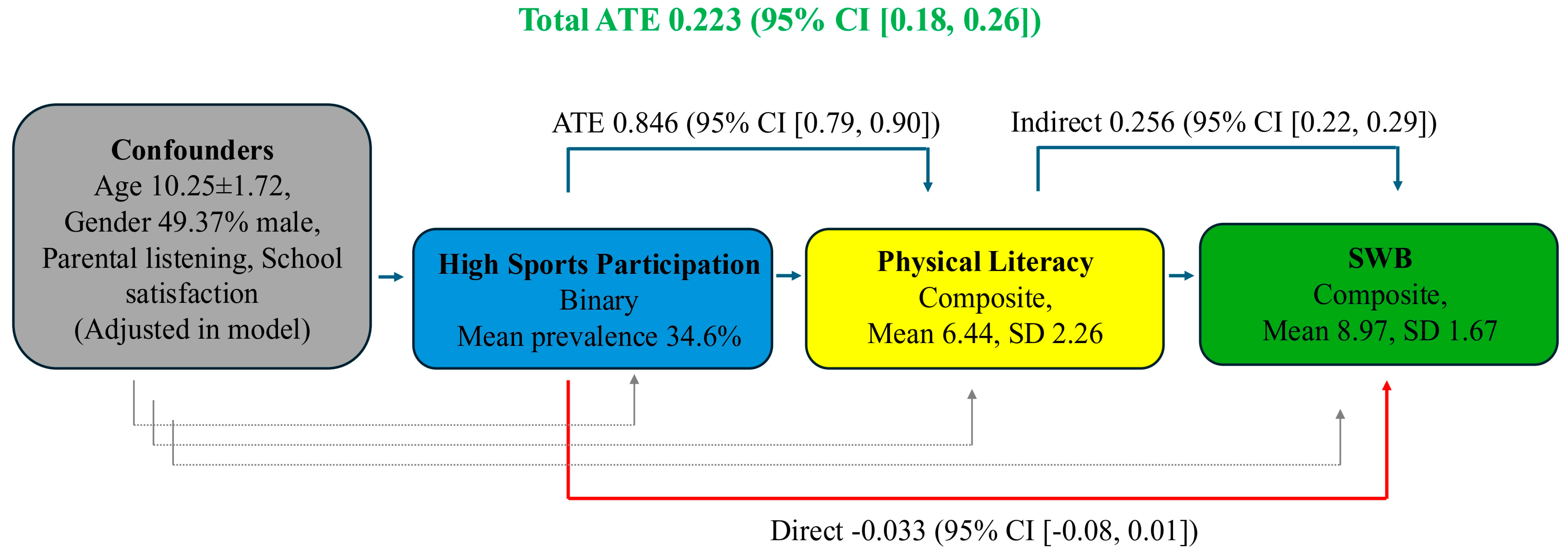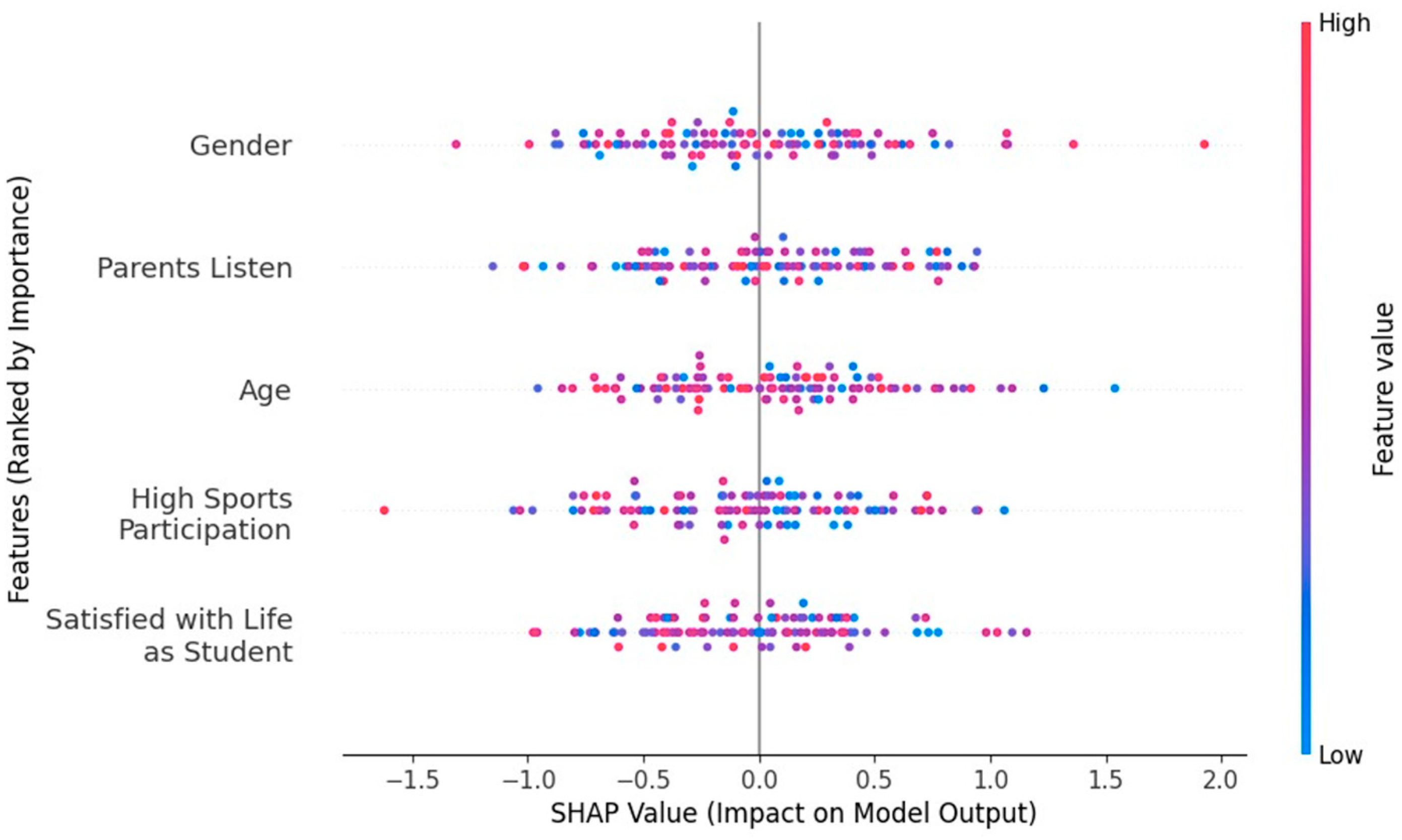Machine Learning-Mediated Analysis of Physical Literacy in Children’s Subjective Well-Being: Evidence from a Multinational Survey
Abstract
1. Introduction
2. Methodology
2.1. Data Source and Preparation
2.2. Measures and Variables
2.3. Data Analysis
3. Results
4. Discussion
5. Conclusions
Author Contributions
Funding
Institutional Review Board Statement
Informed Consent Statement
Data Availability Statement
Acknowledgments
Conflicts of Interest
Abbreviations
| ATE | Average Treatment Effect |
| CATE | Conditional Average Treatment Effect |
| CI | Confidence Interval |
| ISCWeB | International Survey of Children’s Well-Being |
| ML | Machine Learning |
| PDP | Partial Dependence Plot |
| PL | Physical Literacy |
| PYD | Positive Youth Development |
| SD | Standard Deviation |
| SDT | Self-Determination Theory |
| SHAP | SHapley Additive exPlanations |
| SWB | Subjective Well-Being |
References
- Diener, E.; Oishi, S.; Lucas, R.E. Subjective well-being: The science of happiness and life satisfaction. In The Oxford Handbook of Positive Psychology; Oxford University Press: Oxford, UK, 2009. [Google Scholar]
- Diener, E.; Suh, E.M.; Lucas, R.E.; Smith, H.L. Subjective well-being: Three decades of progress. Psychol. Bull. 1999, 125, 276. [Google Scholar] [CrossRef]
- Butler, J.; Kern, M.L. The PERMA-Profiler: A brief multidimensional measure of flourishing. Int. J. Wellbeing 2016, 6, 1–48. [Google Scholar] [CrossRef]
- Ryff, C.D. Psychological well-being revisited: Advances in the science and practice of eudaimonia. Psychother. Psychosom. 2013, 83, 10–28. [Google Scholar] [CrossRef] [PubMed]
- Seligman, M.E. Flourish: A Visionary New Understanding of Happiness and Well-Being; Simon and Schuster: New York, NY, USA, 2011. [Google Scholar]
- Britton, U.; Issartel, J.; Symonds, J.; Belton, S. What keeps them physically active? Predicting physical activity, motor competence, health-related fitness, and perceived competence in Irish adolescents after the transition from primary to second-level school. Int. J. Environ. Res. Public Health 2020, 17, 2874. [Google Scholar] [CrossRef]
- Whitehead, M. Definition of physical literacy: Developments and issues. In Physical Literacy Across the World; Routledge: Oxfordshire, UK, 2019; pp. 8–18. [Google Scholar]
- Klimenko, L.; Skachkova, L. Subjective Well-Being of Russian Faculty An empirical study. Вопросы образования 2020, 4, 37–63. [Google Scholar] [CrossRef]
- Shin, K.; You, S. Leisure type, leisure satisfaction and adolescents’ psychological wellbeing. J. Pac. Rim Psychol. 2013, 7, 53–62. [Google Scholar] [CrossRef]
- Peris-Delcampo, D.; Núñez, A.; Ortiz-Marholz, P.; Olmedilla, A.; Cantón, E.; Ponseti, J.; Garcia-Mas, A. The bright side of sports: A systematic review on well-being, positive emotions and performance. BMC Psychol. 2024, 12, 284. [Google Scholar] [CrossRef]
- Ryan, R.M.; Deci, E.L. Self-determination theory. In Encyclopedia of Quality of Life and Well-Being Research; Springer: Berlin/Heidelberg, Germany, 2024; pp. 6229–6235. [Google Scholar]
- Lerner, R.M.; Lerner, J.V.; Almerigi, J.B.; Theokas, C.; Phelps, E.; Gestsdottir, S.; Naudeau, S.; Jelicic, H.; Alberts, A.; Ma, L. Positive youth development, participation in community youth development programs, and community contributions of fifth-grade adolescents: Findings from the first wave of the 4-H study of positive youth development. J. Early Adolesc. 2005, 25, 17–71. [Google Scholar] [CrossRef]
- Holt, N.L.; Neely, K.C. Positive youth development through sport: A review. Rev. Iberoam. Psicol. Ejerc. Deporte 2011, 6, 299–316. [Google Scholar]
- Cairney, J.; Dudley, D.; Kwan, M.; Bulten, R.; Kriellaars, D. Physical literacy, physical activity and health: Toward an evidence-informed conceptual model. Sports Med. 2019, 49, 371–383. [Google Scholar] [CrossRef]
- Edwards, L.C.; Bryant, A.S.; Keegan, R.J.; Morgan, K.; Jones, A.M. Definitions, foundations and associations of physical literacy: A systematic review. Sports Med. 2017, 47, 113–126. [Google Scholar] [CrossRef]
- Longmuir, P.E.; Boyer, C.; Lloyd, M.; Yang, Y.; Boiarskaia, E.; Zhu, W.; Tremblay, M.S. The Canadian assessment of physical literacy: Methods for children in grades 4 to 6 (8 to 12 years). BMC Public Health 2015, 15, 767. [Google Scholar] [CrossRef]
- Prats, A.N.; Delcampo, D.P.; Marholz, P.O.; Mas, A.G. The shield of health: Relations of physical activity and psychological wellbeing. Retos Nuevas Tend. Educ. Física Deporte Recreación 2025, 71, 412–428. [Google Scholar]
- Melby, P.S.; Nielsen, G.; Brønd, J.C.; Tremblay, M.S.; Bentsen, P.; Elsborg, P. Associations between Children’s Physical Literacy and Well-Being: Is Physical Activity a Mediator? BMC Public Health 2022, 22, 1267. [Google Scholar] [CrossRef]
- Melby, P.S.; Elsborg, P.; Nielsen, G.; Lima, R.A.; Bentsen, P.; Andersen, L.B. Exploring the importance of diversified physical activities in early childhood for later motor competence and physical activity level: A seven-year longitudinal study. BMC Public Health 2021, 21, 1492. [Google Scholar] [CrossRef]
- Britton, Ú.; Onibonoje, O.; Belton, S.; Behan, S.; Peers, C.; Issartel, J.; Roantree, M. Moving well-being well: Using machine learning to explore the relationship between physical literacy and well-being in children. Appl. Psychol. Health Well-Being 2023, 15, 1110–1129. [Google Scholar] [CrossRef]
- Yang, X.; Wang, M.; Wang, J.; Zhang, S.; Yang, X.; Zhao, L. Physical literacy and health of Chinese medical students: The chain mediating role of physical activity and subjective well-being. Front. Public Health 2024, 12, 1348743. [Google Scholar] [CrossRef]
- Yan, W.; Meng, Y.; Wang, L.; Zhang, T.; Chen, L.; Li, H. Research on the relationship between physical literacy, physical activity and sedentary behavior. Int. J. Environ. Res. Public Health 2022, 19, 16455. [Google Scholar] [CrossRef]
- Gao, T.Y.; Huang, F.H.; Liu, T.; Sum, R.K.W.; De Liu, J.; Tang, D.; Cai, D.Y.; Jiang, Z.K.; Ma, R.S. The role of physical literacy and mindfulness on health-related quality of life among college students during the COVID-19 pandemic. Sci. Rep. 2024, 14, 237. [Google Scholar] [CrossRef] [PubMed]
- de Souza-Lima, J.; Ferrari, G.; Yáñez-Sepúlveda, R.; Giakoni-Ramírez, F.; Muñoz-Strale, C.; Alarcon-Aguilar, J.; Parra-Saldias, M.; Duclos-Bastias, D.; Godoy-Cumillaf, A.; Merellano-Navarro, E.; et al. Prediction of Children’s Subjective Well-Being from Physical Activity and Sports Participation Using Machine Learning Techniques: Evidence from a Multinational Study. Children 2025, 12, 1083. [Google Scholar] [CrossRef] [PubMed]
- Ma, R.; Liu, T.; Raymond Sum, K.W.; Gao, T.; Li, M.; Choi, S.M.; Huang, Y.; Xiang, W. Relationship among physical literacy, mental health, and resilience in college students. Front. Psychiatry 2021, 12, 767804. [Google Scholar] [CrossRef]
- Gross-Manos, D.; Kosher, H.; Ben-Arieh, A. Research with children: Lessons learned from the international survey of children’s wellbeing. Child Indic. Res. 2021, 14, 2097–2118. [Google Scholar] [CrossRef]
- Van Buuren, S.; Van Buuren, S. Flexible Imputation of Missing Data; CRC Press: Boca Raton, FL, USA, 2012; Volume 10. [Google Scholar]
- De Souza-Lima, J.; Gerson, F.; Yáñez-Sepúlveda, R.; Giakoni-Ramirez, F.; Muñoz-Strale, C.; Alarcon-Aguilar, J.; Parra-Saldias, M.; Duclos-Bastias, D.; Godoy-Cumillaf, A.; Merellano-Navarro, E.; et al. Differences in School Stress and Academic Satisfaction in Pre-Adolescents: The Role of Physical Activity. Prepr. Org. 2025, 12, 1282. [Google Scholar] [CrossRef]
- Tavakol, M.; Dennick, R. Making sense of Cronbach’s alpha. Int. J. Med. Educ. 2011, 2, 53. [Google Scholar] [CrossRef]
- WHO. WHO Guidelines on Physical Activity and Sedentary Behaviour; World Health Organization: Geneva, Switzerland, 2020. [Google Scholar]
- Imai, K.; Keele, L.; Tingley, D. A general approach to causal mediation analysis. Psychol. Methods 2010, 15, 309. [Google Scholar] [CrossRef]
- Chernozhukov, V.; Chetverikov, D.; Demirer, M.; Duflo, E.; Hansen, C.; Newey, W.; Robins, J. Double/Debiased Machine Learning for Treatment and Structural Parameters; Oxford University Press: Oxford, UK, 2018. [Google Scholar]
- Efron, B.; Tibshirani, R.J. An Introduction to the Bootstrap; Chapman and Hall: London, UK; CRC: Boca Raton, FL, USA, 1994. [Google Scholar]
- Lundberg, S.M.; Lee, S.-I. A unified approach to interpreting model predictions. Adv. Neural Inf. Process. Syst. 2017, 30, 1–10. [Google Scholar]
- Cohen, J. Statistical Power Analysis for the Behavioral Sciences; Routledge: Oxforshire, UK, 2013. [Google Scholar]
- Rees, G. Children? Views on Their Lives and Well-Being; Springer: Berlin/Heidelberg, Germany, 2017. [Google Scholar]
- MacKinnon, D.P.; Krull, J.L.; Lockwood, C.M. Equivalence of the mediation, confounding and suppression effect. Prev. Sci. 2000, 1, 173–181. [Google Scholar] [CrossRef] [PubMed]
- Ryan Richard, M.; Deci, E.L. Self-determination theory and the facilitation of intrinsic motivation, social development, and well-being. Am. Psychol. 2000, 55, 68–78. [Google Scholar] [CrossRef]
- Dong, X.; Huang, F.; Shi, X.; Xu, M.; Yan, Z.; Türegün, M. Mediation impact of physical literacy and activity between psychological distress and life satisfaction among college students during COVID-19 pandemic. Sage Open 2023, 13, 21582440231162503. [Google Scholar] [CrossRef]
- Liu, Q.; Zhu, W.-d.; Lou, H.; Zhang, D.-y.; Mu, F.-z.; Zhang, X.-y.; Li, Y.-h.; Zhang, W.-h.; He, M.-h.; Li, C.-x. The influence of physical activity on emotional management ability in college students: A chain mediating role of psychological resilience and health literacy. BMC Public Health 2025, 25, 2878. [Google Scholar] [CrossRef] [PubMed]
- Bruk, Z.; Ignatjeva, S. Predictors of Child Well-Being or What Makes Children Happy. In Happiness Wellness—Biopsychosocial and Anthropological Perspectives; IntechOpen: Rijeka, Croatia, 2019; p. 181. [Google Scholar] [CrossRef]



| Variable | Mean (SD) or % | Range |
|---|---|---|
| Age (years) | 10.25 (1.72) | 6.0–14.0 |
| Gender (% female) | 50.6% | – |
| Subjective well-being (0–10) | 8.67 (1.85) | 0.0–10.0 |
| Physical literacy (0–10) | 6.44 (2.26) | 0.0–10.0 |
| High sports participation | 34.6% | – |
| Parents listen (0–4) | 3.18 (1.10) | 0.0–4.0 |
| Satisfied life as student (0–10) | 8.44 (2.15) | 0.0–10.0 |
| Effect | Estimate | 95% CI | Std. Effect (d) |
|---|---|---|---|
| ATE on PL (a) | 0.111 | N/A | 0.049 (0.111/SD PL ~2.26) |
| Total ATE (c) | 0.083 | [0.073, 0.094] | 0.050 (0.083/SD SWB ~1.67) |
| Indirect (ab) | 0.055 | [0.049, 0.061] | 0.033 |
| Direct (c_prime) | 0.028 | [0.020, 0.038] | 0.017 |
| Mediation proportion | 0.660 | N/A | N/A |
| Variable | Mean | SHAP | Value |
|---|---|---|---|
| Satisfied life as a student | +0.28 | 0.495 | 8.44 (2.15) |
| Parents listen | +0.20 | 0.382 | 3.18 (1.10) |
| High sports participation | +0.15 | 0.178 | 34.6% |
| Gender (female) | –0.02 | –0.012 | 50.6% |
| Age | –0.05 | –0.112 | 10.25 (1.72) |
| Age (Years) | Mean SWB | SD |
|---|---|---|
| 8 | 8.88 | 1.70 |
| 9 | 8.87 | 1.68 |
| 10 | 8.84 | 1.73 |
| 11 | 8.82 | 1.70 |
| 12 | 8.51 | 1.89 |
| 13 | 8.37 | 2.09 |
| 14 | 8.09 | 2.33 |
| By Gender | Mean | SD |
|---|---|---|
| Male | 8.71 | 1.79 |
| Female | 8.64 | 1.89 |
Disclaimer/Publisher’s Note: The statements, opinions and data contained in all publications are solely those of the individual author(s) and contributor(s) and not of MDPI and/or the editor(s). MDPI and/or the editor(s) disclaim responsibility for any injury to people or property resulting from any ideas, methods, instructions or products referred to in the content. |
© 2025 by the authors. Licensee MDPI, Basel, Switzerland. This article is an open access article distributed under the terms and conditions of the Creative Commons Attribution (CC BY) license (https://creativecommons.org/licenses/by/4.0/).
Share and Cite
Souza-Lima, J.d.; Ortiz-Marholz, P.; Ferrari, G.; Parra-Saldias, M.; Duclos-Bastias, D.; Godoy-Cumillaf, A.; Merellano-Navarro, E.; Bruneau-Chávez, J.; Peris-Delcampo, D.; Farias-Valenzuela, C.; et al. Machine Learning-Mediated Analysis of Physical Literacy in Children’s Subjective Well-Being: Evidence from a Multinational Survey. Psychiatry Int. 2025, 6, 131. https://doi.org/10.3390/psychiatryint6040131
Souza-Lima Jd, Ortiz-Marholz P, Ferrari G, Parra-Saldias M, Duclos-Bastias D, Godoy-Cumillaf A, Merellano-Navarro E, Bruneau-Chávez J, Peris-Delcampo D, Farias-Valenzuela C, et al. Machine Learning-Mediated Analysis of Physical Literacy in Children’s Subjective Well-Being: Evidence from a Multinational Survey. Psychiatry International. 2025; 6(4):131. https://doi.org/10.3390/psychiatryint6040131
Chicago/Turabian StyleSouza-Lima, Josivaldo de, Paula Ortiz-Marholz, Gerson Ferrari, Maribel Parra-Saldias, Daniel Duclos-Bastias, Andrés Godoy-Cumillaf, Eugenio Merellano-Navarro, José Bruneau-Chávez, David Peris-Delcampo, Claudio Farias-Valenzuela, and et al. 2025. "Machine Learning-Mediated Analysis of Physical Literacy in Children’s Subjective Well-Being: Evidence from a Multinational Survey" Psychiatry International 6, no. 4: 131. https://doi.org/10.3390/psychiatryint6040131
APA StyleSouza-Lima, J. d., Ortiz-Marholz, P., Ferrari, G., Parra-Saldias, M., Duclos-Bastias, D., Godoy-Cumillaf, A., Merellano-Navarro, E., Bruneau-Chávez, J., Peris-Delcampo, D., Farias-Valenzuela, C., & Valdivia-Moral, P. (2025). Machine Learning-Mediated Analysis of Physical Literacy in Children’s Subjective Well-Being: Evidence from a Multinational Survey. Psychiatry International, 6(4), 131. https://doi.org/10.3390/psychiatryint6040131











